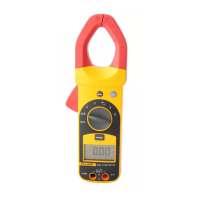312, 316, 318
2
• When using probes, keep your fingers behind the
finger guards.
• When making electrical connections, connect the
common test lead before connecting the live test lead;
when disconnecting, disconnect the live test lead
before disconnecting the common test lead.
• Disconnect circuit power and discharge all high-
voltage capacitors before testing resistance,
continuity, or diodes.
• Use only a single 9 V battery, properly installed in the
Meter case, to power the Meter.
• Replace the battery as soon as the low battery
indicator (
B) appears to avoid false readings that can
lead to electric shock and injury.
• Check Meter operation on a known source before and
after use.
• When servicing, use only specified replacement parts.
• Adhere to local and national safety codes. Industrial
protective equipment must be used to prevent shock
and arc blast injury where hazardous live conductors
were exposed.
• Do not hold the Current Probe anywhere beyond the
tactile indicator (see Figure 1).
Environmental Conditions:
Altitude: up to 2000 meters.
Operating temperature: 0 °C ~ 30 °C, up to 90 % RH, non-
condensing
30 °C ~ 40 °C, up to 80% RH, non-condensing
Storage temperature: -10 °C ~ 60 °C, battery removed
Pollution Degree: 2
Measurement Categories: CAT III (600 V), CAT II (1000 V)
Electromagnetic Compatibility: 3 V/m, performance criterion B

